2009 Hyundai Santa Fe coolant
[x] Cancel search: coolantPage 179 of 269
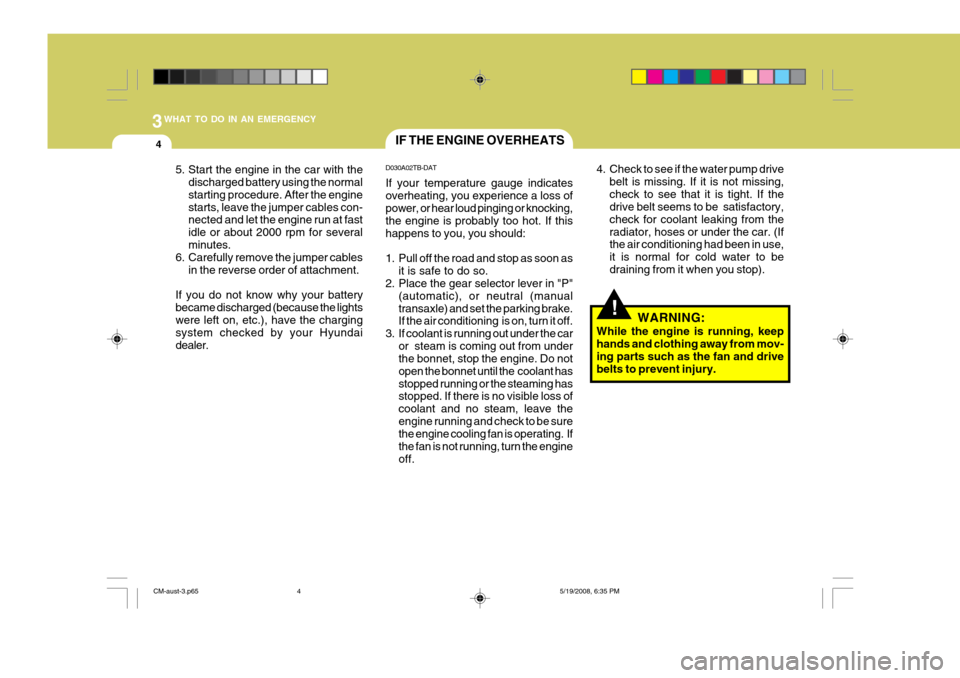
3WHAT TO DO IN AN EMERGENCY
4
!
IF THE ENGINE OVERHEATS
4. Check to see if the water pump drivebelt is missing. If it is not missing, check to see that it is tight. If the drive belt seems to be satisfactory, check for coolant leaking from theradiator, hoses or under the car. (If the air conditioning had been in use, it is normal for cold water to bedraining from it when you stop).
D030A02TB-DAT If your temperature gauge indicates overheating, you experience a loss of power, or hear loud pinging or knocking, the engine is probably too hot. If thishappens to you, you should:
1. Pull off the road and stop as soon as
it is safe to do so.
2. Place the gear selector lever in "P"
(automatic), or neutral (manual transaxle) and set the parking brake. If the air conditioning is on, turn it off.
3. If coolant is running out under the car or steam is coming out from underthe bonnet, stop the engine. Do not open the bonnet until the coolant hasstopped running or the steaming has stopped. If there is no visible loss of coolant and no steam, leave theengine running and check to be sure the engine cooling fan is operating. If the fan is not running, turn the engineoff. WARNING:
While the engine is running, keephands and clothing away from mov-ing parts such as the fan and drive belts to prevent injury.
5. Start the engine in the car with the
discharged battery using the normal starting procedure. After the enginestarts, leave the jumper cables con- nected and let the engine run at fast idle or about 2000 rpm for severalminutes.
6. Carefully remove the jumper cables
in the reverse order of attachment.
If you do not know why your batterybecame discharged (because the lightswere left on, etc.), have the charging system checked by your Hyundai dealer.
CM-aust-3.p65 5/19/2008, 6:35 PM
4
Page 180 of 269
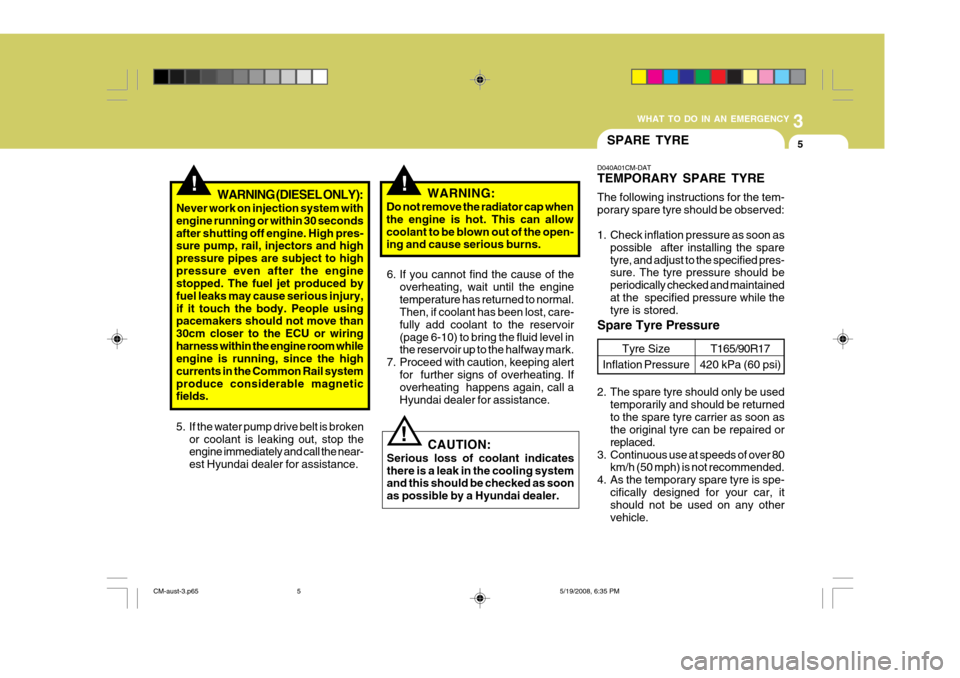
3
WHAT TO DO IN AN EMERGENCY
5
!
5. If the water pump drive belt is broken
or coolant is leaking out, stop the engine immediately and call the near- est Hyundai dealer for assistance. WARNING:
Do not remove the radiator cap whenthe engine is hot. This can allowcoolant to be blown out of the open- ing and cause serious burns.
!WARNING (DIESEL ONLY):
Never work on injection system with engine running or within 30 secondsafter shutting off engine. High pres- sure pump, rail, injectors and high pressure pipes are subject to highpressure even after the engine stopped. The fuel jet produced by fuel leaks may cause serious injury,if it touch the body. People using pacemakers should not move than 30cm closer to the ECU or wiringharness within the engine room while engine is running, since the high currents in the Common Rail systemproduce considerable magnetic fields. 6. If you cannot find the cause of the
overheating, wait until the engine temperature has returned to normal. Then, if coolant has been lost, care- fully add coolant to the reservoir(page 6-10) to bring the fluid level in the reservoir up to the halfway mark.
7. Proceed with caution, keeping alert for further signs of overheating. Ifoverheating happens again, call a Hyundai dealer for assistance.
CAUTION:
Serious loss of coolant indicatesthere is a leak in the cooling system and this should be checked as soon as possible by a Hyundai dealer.
!
SPARE TYRE
D040A01CM-DAT TEMPORARY SPARE TYRE The following instructions for the tem- porary spare tyre should be observed:
1. Check inflation pressure as soon as possible after installing the spare tyre, and adjust to the specified pres- sure. The tyre pressure should be periodically checked and maintainedat the specified pressure while the tyre is stored.
Spare Tyre Pressure
Tyre Size
Inflation PressureT165/90R17
420 kPa (60 psi)
2. The spare tyre should only be used temporarily and should be returned to the spare tyre carrier as soon as the original tyre can be repaired or replaced.
3. Continuous use at speeds of over 80 km/h (50 mph) is not recommended.
4. As the temporary spare tyre is spe-
cifically designed for your car, it should not be used on any other vehicle.
CM-aust-3.p65 5/19/2008, 6:35 PM
5
Page 198 of 269
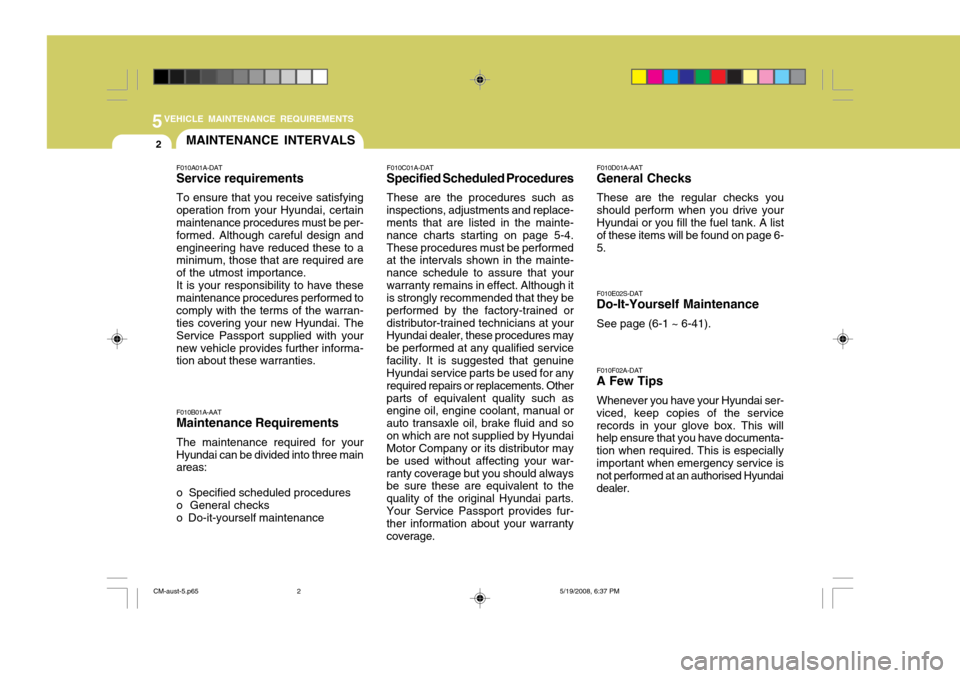
5VEHICLE MAINTENANCE REQUIREMENTS
2MAINTENANCE INTERVALS
F010C01A-DAT
Specified Scheduled Procedures
These are the procedures such as
inspections, adjustments and replace- ments that are listed in the mainte- nance charts starting on page 5-4.These procedures must be performed at the intervals shown in the mainte- nance schedule to assure that yourwarranty remains in effect. Although it is strongly recommended that they be performed by the factory-trained ordistributor-trained technicians at your Hyundai dealer, these procedures may be performed at any qualified servicefacility. It is suggested that genuine Hyundai service parts be used for any required repairs or replacements. Otherparts of equivalent quality such as engine oil, engine coolant, manual or auto transaxle oil, brake fluid and soon which are not supplied by Hyundai Motor Company or its distributor may be used without affecting your war-ranty coverage but you should always be sure these are equivalent to the quality of the original Hyundai parts.Your Service Passport provides fur- ther information about your warranty coverage. F010E02S-DAT
Do-It-Yourself Maintenance
See page (6-1 ~ 6-41).
F010D01A-AAT
General Checks
These are the regular checks youshould perform when you drive your Hyundai or you fill the fuel tank. A list of these items will be found on page 6-5. F010F02A-DAT
A Few Tips
Whenever you have your Hyundai ser-
viced, keep copies of the service records in your glove box. This will help ensure that you have documenta- tion when required. This is especiallyimportant when emergency service is not performed at an authorised Hyundai dealer.
F010B01A-AAT Maintenance Requirements The maintenance required for your Hyundai can be divided into three main areas: o Specified scheduled procedures o General checks o Do-it-yourself maintenance
F010A01A-DAT Service requirements To ensure that you receive satisfying operation from your Hyundai, certain maintenance procedures must be per- formed. Although careful design andengineering have reduced these to a minimum, those that are required are of the utmost importance.It is your responsibility to have thesemaintenance procedures performed tocomply with the terms of the warran- ties covering your new Hyundai. The Service Passport supplied with yournew vehicle provides further informa- tion about these warranties.
CM-aust-5.p65
5/19/2008, 6:37 PM
2
Page 202 of 269
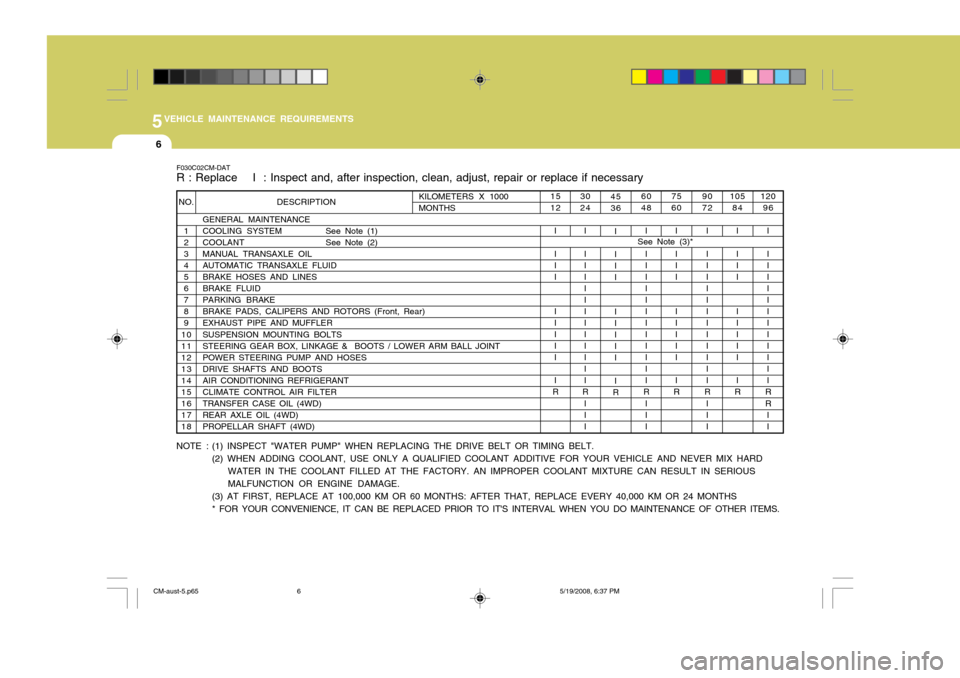
5VEHICLE MAINTENANCE REQUIREMENTS
6
F030C02CM-DAT R : Replace I : Inspect and, after inspection, clean, adjust, repair or replace if necessary
NOTE : (1) INSPECT "WATER PUMP" WHEN REPLACING THE DRIVE BELT OR TIMING BELT. (2) WHEN ADDING COOLANT, USE ONLY A QUALIFIED COOLANT ADDITIVE FOR YOUR VEHICLE AND NEVER MIX HARD
WATER IN THE COOLANT FILLED AT THE FACTORY. AN IMPROPER COOLANT MIXTURE CAN RESULT IN SERIOUS MALFUNCTION OR ENGINE DAMAGE.
(3) AT FIRST, REPLACE AT 100,000 KM OR 60 MONTHS: AFTER THAT, REPLACE EVERY 40,000 KM OR 24 MONTHS * FOR YOUR CONVENIENCE, IT CAN BE REPLACED PRIOR TO IT'S INTERVAL WHEN YOU DO MAINTENANCE OF OTHER ITEMS. 75 60
I I II I I III I
R 90 72
I I IIIII I IIIII
R
III
1512
I I II I I III I
R See Note (3)*
DESCRIPTION
GENERAL MAINTENANCE
COOLING SYSTEM See Note (1)COOLANT See Note (2)
MANUAL TRANSAXLE OIL AUTOMATIC TRANSAXLE FLUID BRAKE HOSES AND LINESBRAKE FLUIDPARKING BRAKEBRAKE PADS, CALIPERS AND ROTORS (Front, Rear)EXHAUST PIPE AND MUFFLER SUSPENSION MOUNTING BOLTS STEERING GEAR BOX, LINKAGE & BOOTS / LOWER ARM BALL JOINTPOWER STEERING PUMP AND HOSESDRIVE SHAFTS AND BOOTSAIR CONDITIONING REFRIGERANTCLIMATE CONTROL AIR FILTERTRANSFER CASE OIL (4WD) REAR AXLE OIL (4WD) PROPELLAR SHAFT (4WD)
NO.
123 4 56789
10111213141516 17 18
30 24
I I IIIII I IIIII
R
III 4536
I I II I IIII I
R 60 48
I I IIIII I IIIII
R
III 105
84
I I II I I III I
R 120
96
I I IIIII I IIIII
R R I IKILOMETERS X 1000 MONTHS
CM-aust-5.p65 5/19/2008, 6:37 PM
6
Page 205 of 269
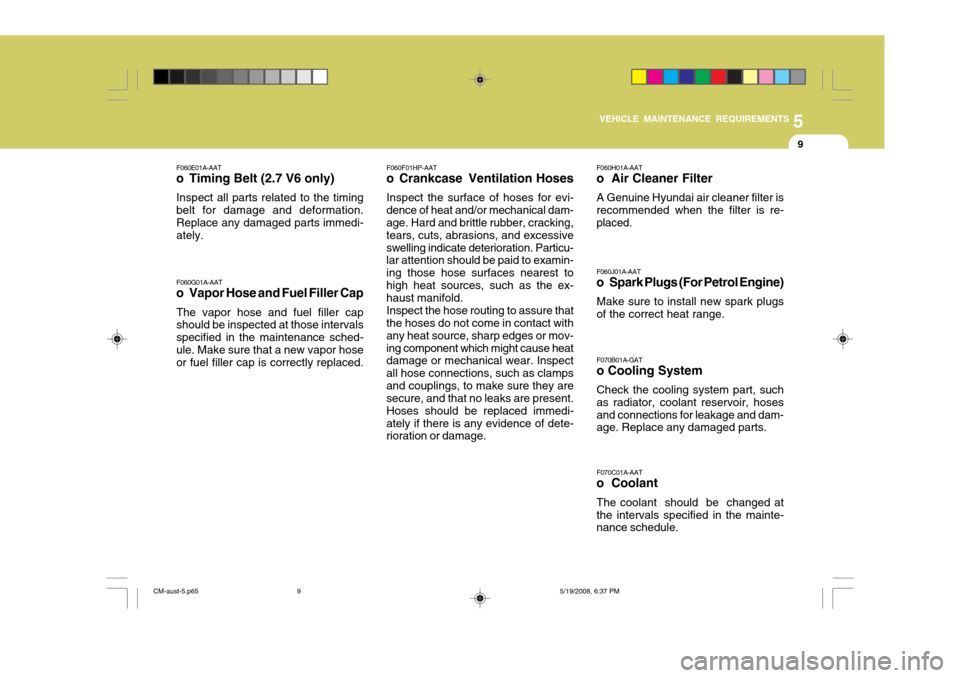
5
VEHICLE MAINTENANCE REQUIREMENTS
9
F060E01A-AAT
o Timing Belt (2.7 V6 only)
Inspect all parts related to the timing belt for damage and deformation. Replace any damaged parts immedi- ately. F060G01A-AAT
o Vapor Hose and Fuel Filler Cap
The vapor hose and fuel filler cap should be inspected at those intervals specified in the maintenance sched-ule. Make sure that a new vapor hose or fuel filler cap is correctly replaced. F060F01HP-AAT
o Crankcase Ventilation Hoses
Inspect the surface of hoses for evi-
dence of heat and/or mechanical dam-age. Hard and brittle rubber, cracking, tears, cuts, abrasions, and excessiveswelling indicate deterioration. Particu- lar attention should be paid to examin- ing those hose surfaces nearest tohigh heat sources, such as the ex- haust manifold.
Inspect the hose routing to assure that
the hoses do not come in contact with any heat source, sharp edges or mov-ing component which might cause heat damage or mechanical wear. Inspect all hose connections, such as clampsand couplings, to make sure they are secure, and that no leaks are present. Hoses should be replaced immedi-ately if there is any evidence of dete- rioration or damage. F060H01A-AAT
o Air Cleaner Filter
A Genuine Hyundai air cleaner filter is recommended when the filter is re- placed. F060J01A-AAT
o Spark Plugs (For Petrol Engine)
Make sure to install new spark plugs of the correct heat range. F070C01A-AAT
o Coolant
The coolant should be changed at the intervals specified in the mainte- nance schedule.
F070B01A-GAT o Cooling System Check the cooling system part, such as radiator, coolant reservoir, hosesand connections for leakage and dam- age. Replace any damaged parts.
CM-aust-5.p65
5/19/2008, 6:37 PM
9
Page 208 of 269
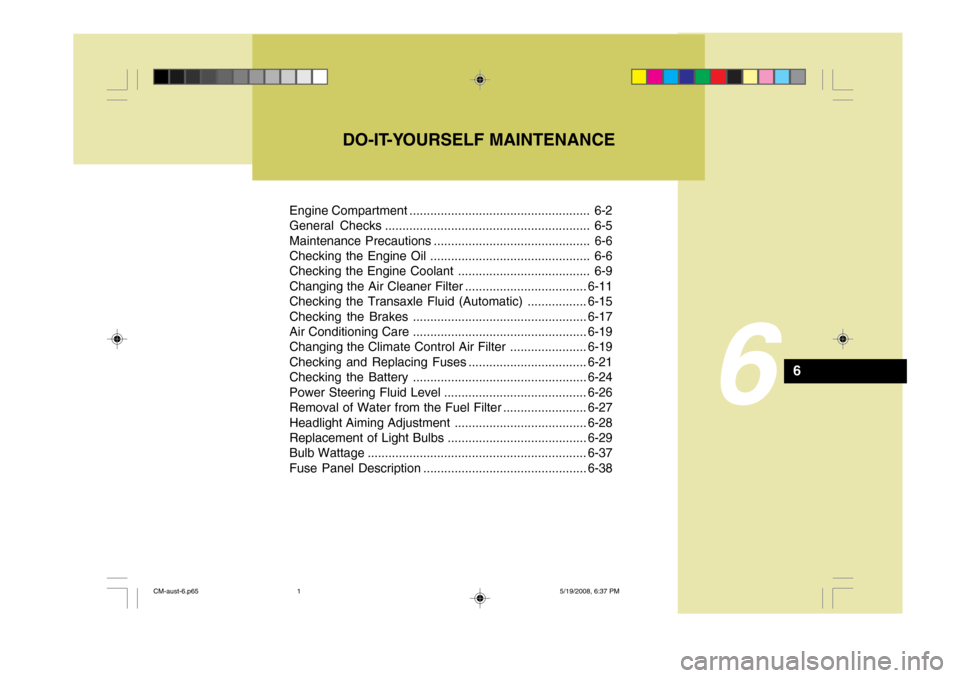
Engine Compartment .................................................... 6-2
General Checks ........................................................... 6-5
Maintenance Precautions ............................................. 6-6
Checking the Engine Oil .............................................. 6-6
Checking the Engine Coolant ...................................... 6-9
Changing the Air Cleaner Filter ...................................6-11
Checking the Transaxle Fluid (Automatic) .................6-15
Checking the Brakes .................................................. 6-17
Air Conditioning Care .................................................. 6-19
Changing the Climate Control Air Filter .. ....................6-19
Checking and Replacing Fuses ..................................6-21
Checking the Battery .................................................. 6-24
Power Steering Fluid Level ......................................... 6-26
Removal of Water from the Fuel Filter ........................6-27
Headlight Aiming Adjustment ...................................... 6-28
Replacement of Light Bulbs ........................................6-29
Bulb Wattage ............................................................... 6-37
Fuse Panel D escription ............................................... 6-38
DO-IT-YOURSELF MAINTENANCE
6
6
CM-aust-6.p65
5/19/2008, 6:37 PM
1
Page 209 of 269
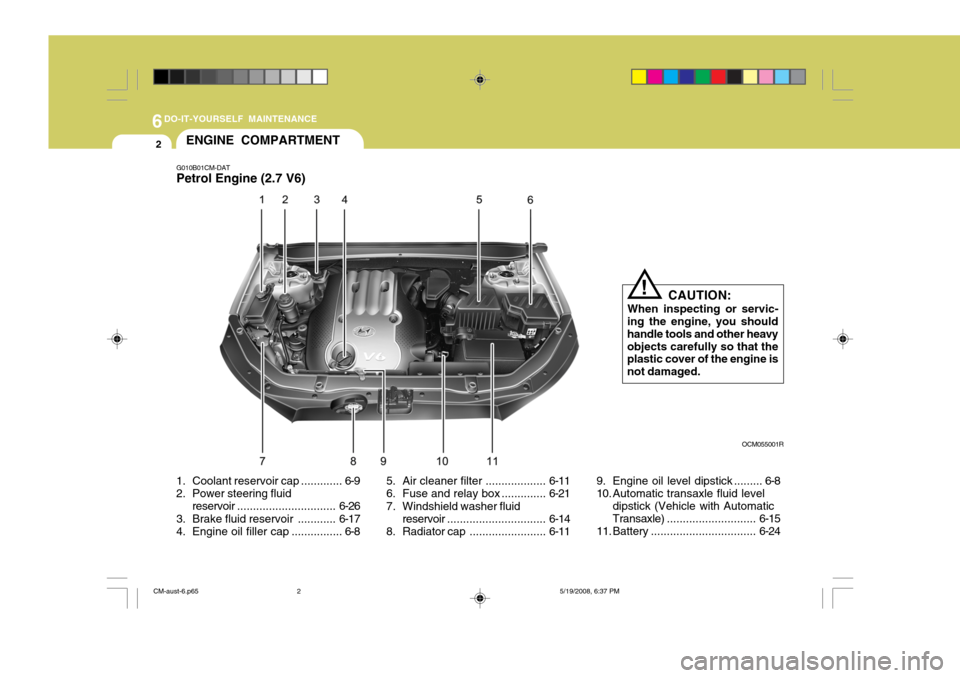
6DO-IT-YOURSELF MAINTENANCE
2ENGINE COMPARTMENT
1. Coolant rese rvoir cap ............. 6-9
2. Power steering fluid
reservoir ............................... 6-26
3. Brake fluid reservoir ............ 6-17
4. Engine oil filler cap ................ 6-8 5. Air cleaner filter ...................
6-11
6. Fuse and relay box .............. 6-21
7. Windshield washer fluid reservoir ............................... 6-14
8. Radiator cap ........................6-11
G010B01CM-DAT Petrol Engine (2.7 V6)
9. Engine oil level dipstick ......... 6-8
10. Automatic transaxle fluid leveldipstick (Vehicle with AutomaticTransaxle) ............................ 6-15
11. Battery ................................. 6-24
CAUTION:
When inspecting or servic-
ing the engine, you shouldhandle tools and other heavyobjects carefully so that the plastic cover of the engine is not damaged.
!
OCM055001R
CM-aust-6.p65 5/19/2008, 6:37 PM
2
Page 210 of 269
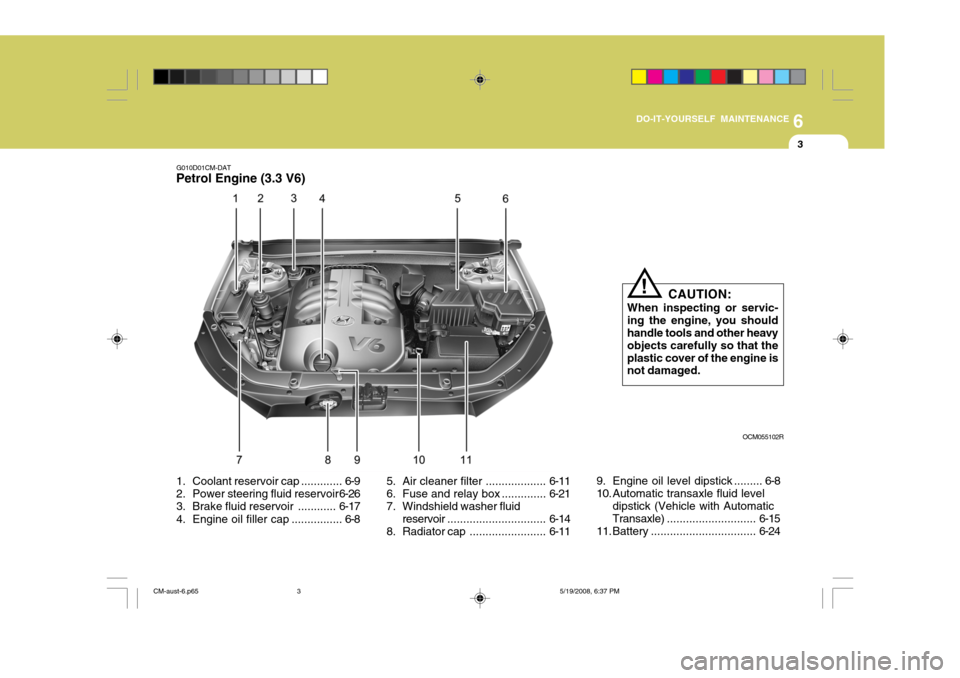
6
DO-IT-YOURSELF MAINTENANCE
3
G010D01CM-DAT
Petrol Engine (3.3 V6)
CAUTION:
When inspecting or servic- ing the engine, you shouldhandle tools and other heavy objects carefully so that the plastic cover of the engine is not damaged.
!
OCM055102R
1. Coolant rese rvoir cap ............. 6-9
2. Power steering fluid reservoir 6-26
3. Brake fluid reservoir ............ 6-17
4. Engine oil filler cap ................ 6-8 5. Air cleaner filter ...................
6-11
6. Fuse and relay box .............. 6-21
7. Windshield washer fluid
reservoir ............................... 6-14
8. Radiat or cap........................ 6-119. Engine oil level dipstick ......... 6-8
10. Automatic transaxle fluid level
dipstick (Vehicle with AutomaticTransaxle) ............................ 6-15
11. Battery ................................. 6-24
CM-aust-6.p65 5/19/2008, 6:37 PM
3